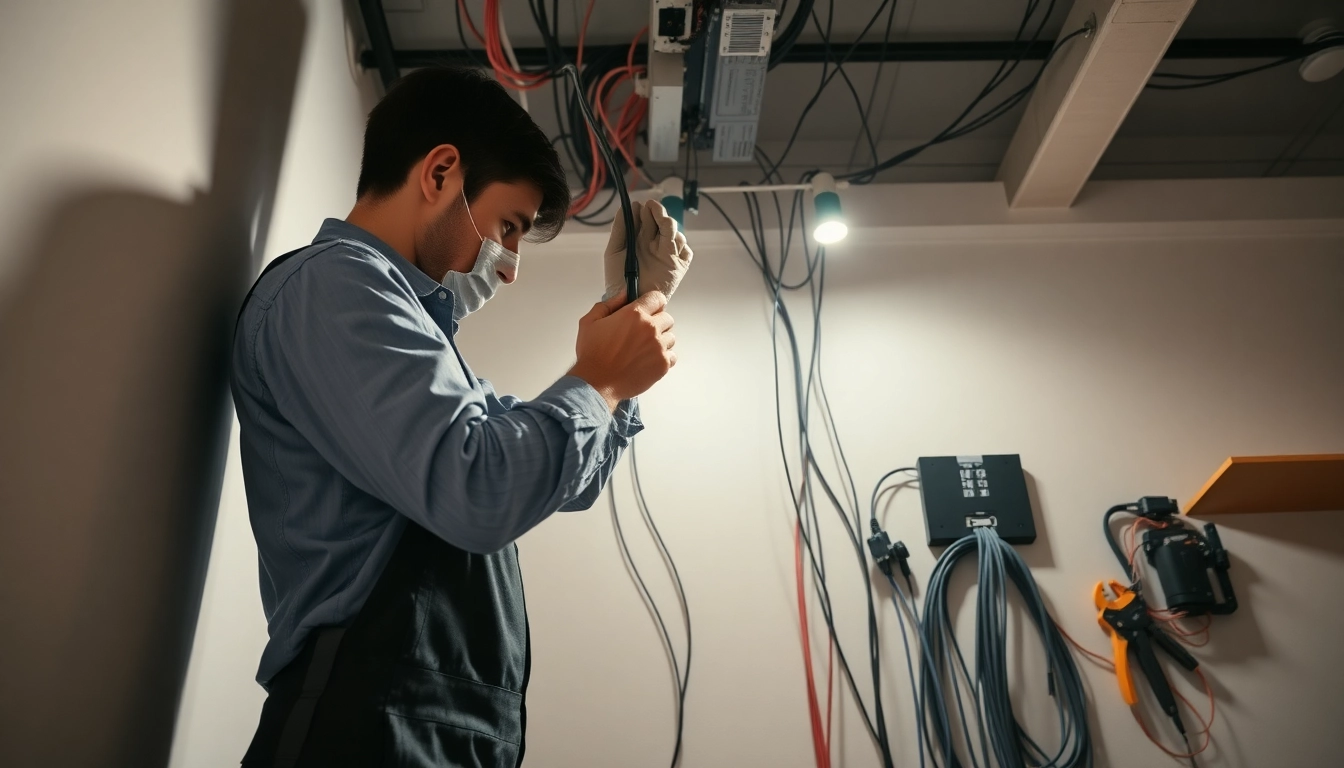Understanding Electrical Installation Basics
Electrical installation is a crucial milestone in the construction and renovation of any residential or commercial property. It encompasses a range of activities, including electrical wiring, installation of devices, and ensuring compliance with safety standards. In essence, electrical installation involves setting up systems to distribute, control, and use electrical energy. To gain a comprehensive understanding of this pivotal area of electrical work, it’s important to delve into its various dimensions, including what it entails, the different types of installations, and the critical importance of compliance and safety. This guide serves as an essential resource for those seeking to navigate the complexities of electrical installation with accuracy and confidence.
What is Electrical Installation?
Electrical installation refers to the complete assembly of electrical equipment, systems, and devices intended to facilitate the distribution of electrical energy throughout a structure. This process includes the installation of wiring systems, circuit breakers, electrical panels, outlets, switches, and various fixtures. The overall goal is to ensure effective power access, which can range from powering appliances and lighting to supporting advanced systems like HVAC or home automation.
To ensure effectiveness, a suitable electrical installation must adhere to local and national electrical codes. These regulations are set to minimize risks such as electrical fires, shocks, and other hazards associated with poor installation practices. Thus, hiring a qualified electrician is often vital, as they possess the requisite skills and knowledge to carry out work that meets established safety standards.
Common Electrical Installation Types
Electrical installations can generally be classified into three broad categories: residential, commercial, and industrial installations. Each type has distinct requirements and common practices:
- Residential Electrical Installations: These include the wiring of homes, apartments, and small buildings. Residential installations focus primarily on safety and comfort, providing power for lighting, appliances, and electronics.
- Commercial Electrical Installations: These installations cater to businesses and include office buildings, retail outlets, and commercial facilities. They involve more complex wiring systems to accommodate larger loads, office equipment, and modern technologies.
- Industrial Electrical Installations: Focused on manufacturing plants, warehouses, and factories, industrial installations often require highly specialized knowledge. They involve large machinery, heavy-duty outlets, and robust safety measures due to the higher risk associated with industrial equipment.
The Importance of Compliance and Safety
Safety is the foremost priority in any electrical installation. Compliance with local building codes and regulations ensures that all wiring, devices, and systems are safe for use and efficient. Neglecting these regulations can lead to dire consequences such as electrical shocks, fires, or even fatalities. It’s essential for both DIY enthusiasts and professional electricians to be acutely aware of safety practices.
Additionally, inspections and continual maintenance of installed electrical systems enhance safety over time. Regular checks conducted by licensed electricians help identify potential issues before they escalate, ensuring long-term safety and functionality of the electrical infrastructure.
Planning Your Electrical Installation
Assessing Your Electrical Needs
A successful electrical installation begins with a comprehensive assessment of your electrical needs. This involves evaluating the purpose of the building, determining the necessary power requirements, and considering future expansions or additions. A detailed needs assessment not only aids in planning but also aids in budgeting and ensuring adequate resources are allocated.
Consider factors such as the number of rooms, lighting requirements, and the types of appliances you plan to use. For residential installations, a simple layout might work for small homes, while larger properties will require a more intricate approach. For commercial spaces, power usage may significantly vary depending on equipment needs and operational hours, necessitating a tailored electrical plan to prevent outages or inefficiencies.
Choosing the Right Tools and Equipment
An essential aspect of any electrical installation is the selection of appropriate tools and equipment. Not only does this ensure the quality of the work, but it also supports adherence to safety standards. Basic tools may include wire cutters, voltage testers, screwdrivers, and cable strippers, while complex installations may require advanced equipment such as circuit analyzers or thermal imaging cameras.
Moreover, understanding the characteristics of different types of wires, breakers, and fixtures will impact both the safety and functionality of your installation. Consulting with a professional can provide invaluable insight on which equipment best suits your specific needs.
Creating a Comprehensive Layout
Creating a comprehensive layout that illustrates the placement of outlets, switches, and fixtures is crucial. This diagram should be as detailed as possible and consider light sources, furniture arrangements, and appliance placements to ensure optimal functionality.
A blueprint that maps out the installation points not only improves organization but also allows electricians to anticipate issues such as overloaded circuits or electrical miles, thus preventing future complications.
The Electrical Installation Process Explained
Step-by-Step Wiring Techniques
Once planning is complete, the installation process can begin. This typically starts with laying out the wiring according to the planned layout. The following step-by-step techniques can help ensure a smooth installation:
- Check all tools and equipment against the requirements of your project.
- Map out your circuit layout, highlighting where each outlet, switch, and fixture will be installed.
- Install the necessary conduits, making sure they meet local codes for the environment you’ll be installing them in.
- Thread wires through these conduits, ensuring to follow the layout plan carefully.
- Securely connect wires to outlets, switches, and fixtures, adhering to color-coding standards for safety.
- Ensure proper grounding to prevent electrical shock hazards.
Connection to Power Sources and Outlets
Connection to the power source and outlets is a pivotal phase of the installation. Electricians should ensure adherence to approved techniques, utilizing appropriately rated circuit breakers for specific loads. The connection process involves integrating the wiring to the main electrical panel, which serves as the hub where power is distributed throughout the building.
Consideration must be given to load calculations, circuit ratings, and safety standards. For example, a dedicated circuit may be required for heavy-duty appliances like refrigerators, air conditioning units, or washing machines. Failing to adhere to these guidelines can lead to overloaded circuits—an issue that poses a substantial fire hazard.
Testing and Troubleshooting
Upon completion of the installation, rigorous testing is required to ensure that all components are functioning properly and safely. This process should include:
- Visual inspections of all connections and components to identify issues such as loose wires or poorly connected devices.
- Using testers to check voltage and continuity of circuits.
- Running devices and appliances to ensure they operate smoothly under load.
Troubleshooting should be systematic; if issues arise, start by checking the simplest solutions before advancing to more complex components. Staying methodical not only saves time but minimizes potential risks during testing.
Cost Considerations for Electrical Installation
Average Costs and Budgeting
When it comes to electrical installations, understanding the structure of costs is vital for effective budgeting. The average cost of an electrical installation can vary significantly based on multiple factors, including the complexity of the work, geographical area, and labor costs. On average, installing wiring in a home may run between $4 to $25 per square foot, while more extensive or specialized installations may lead to higher expenses.
Creating a flexible budget that accounts for unforeseen expenses, such as revisions in the plan, material costs fluctuations, or additional labor will ultimately streamline the financial aspect of your installation. Consulting professionals for estimates can provide clarity and better budgeting strategies.
Factors Influencing Installation Prices
Several factors influence the cost of electrical installations, including:
- Geographical Location: Costs can vary between urban and rural areas due to labor rates and the availability of skilled electricians.
- Type of Installation: Residential projects may be less expensive than commercial or industrial undertakings, which often require greater skill and more extensive labor.
- System Requirements: Homes with complex systems such as smart home technologies or renewable energy sources will typically have higher installation costs.
Furthermore, careful planning and execution can influence costs positively. Long-term projections of operating expenses resulting from energy efficiency considerations should also bear weight in budgeting discussions.
Financing Options for Major Installations
For larger projects, financing options can alleviate the weight of upfront costs. Home equity loans, personal loans, or lines of credit can be viable solutions for funding significant electrical installations. Alternatively, many contractors may offer financing plans that allow clients to pay over time.
Researching available incentives or tax credits associated with energy-efficient systems may also yield financial advantages. Many local programs aim to incentivize renewable energy systems or upgrades that enhance energy efficiency, providing additional funding sources for traditional electrical installations.
Maintaining Your Electrical Systems Post-Installation
Regular Inspection and Upkeep
Once installation is complete, ongoing maintenance becomes critical to ensuring safety and functionality. Regular inspections can prolong the life of electrical systems and prevent potential hazards. Homeowners and property managers should engage certified electricians for periodic checks, focusing on:
- Identification of wear and tear on equipment and wiring.
- Testing of circuit breakers and fuses to ensure proper function.
- Assessment of ongoing compliance with local codes.
Addresses such upkeep not only bolsters safety but can also optimize performance in the long run, enhancing energy efficiency across systems.
Signs that Indicate Need for Electrical Installation Updates
Recognizing when updates to your electrical installation are necessary can prevent serious issues. Below are some warning signs to monitor:
- Frequent tripping of circuit breakers indicates overloaded circuits.
- Flickering lights often signify problems with wiring connections.
- Warm or hot outlets can indicate unsafe wiring conditions or failing devices.
- The property’s electrical system is older than 40 years and may not comply with modern standards.
Addressing these signs in a timely manner is crucial for safety, efficiency, and compliance with current regulations.
Connecting with Professional Electricians
When in doubt, connecting with licensed and certified professionals is the best course of action for electrical work. Professional electricians carry the necessary training and qualifications to handle complex installations, ensuring compliance with legal standards and minimizing long-term risks.
It is also advisable to engage multiple electricians for consultations. Obtaining multiple estimates allows homeowners and businesses to compare approaches, costs, and timelines, ensuring a more informed decision when selecting a service provider.



